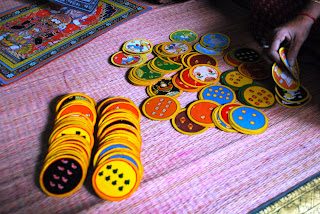 The nava-gunjara (Vishnu in the composite form
The nava-gunjara (Vishnu in the composite form  The nava-gunjara (Vishnu in the composite form
The nava-gunjara (Vishnu in the composite form  The Dashavatar Set, 52 colours
The Dashavatar Set, 52 colours The nava-gunjara (Vishnu in the composite form
The nava-gunjara (Vishnu in the composite form 
 The Dashavatar Set,12 colours
The Dashavatar Set,12 coloursDasavatara Ganjifa
Ganjifa cards were usually hand-painted. This version was printed chromo-lithographically by the Chitrasala Press in around 1950. Ten suits of twelve cards, each suit is based on one of the ten incarnations of Vishnu. An upper court card, Raja, a lower court card, Pradhan or Mantri, and ten numerals in each suit. Suits are: Matsya (fish), Kurma (turtle), Varaha (boar), Narasimha (lion), Vamana (water pot), Parashurama (axe), Rama (bow & arrow, or monkey), Krishna (quoit or cow), Buddha (conch) and Kalkin (sword or horse).








120 Cards, 2¾" in diameter, printed by Chitrasala Press, Pune, around 1950 with either black, red or white backs.


All of the Pradhans are shown riding on white horses (middle row). The God Vishnu is shown on the
Raja cards (top row).








Madhurimaji, Congrats. You have done praiseworthy efforts to justify the valuable tradition of Indian Ganjifa art. I appreciate your work.
ReplyDeleteProf. NIsarg Ahir, Ahmedabad.